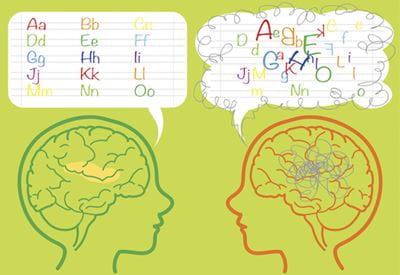Learning disabilities: what are they and what can we do about them?
The term “learning disability” is thrown around pretty loosely these days, yet it’s hard for most of us to come up with an accurate definition of what is actually meant by those words. It’s important for parents to have some idea, though, of what learning disabilities are and what can be done about them. This knowledge will equip you to recognize a problem and get the appropriate help in a timely manner if your child does suffer from a learning disability.
What is a learning disability?
 Learning disabilities are sometimes called invisible disabilities because they are often difficult to detect, and there may be no physical clues to indicate a child is not functioning normally. It’s a general term encompassing many different disorders that describe a person’s seemingly unexplained and unexpected difficulty acquiring certain academic skills. Some experts define it as the gap between what a person is intellectually capable of learning and the level at which they perform academically.
Learning disabilities are sometimes called invisible disabilities because they are often difficult to detect, and there may be no physical clues to indicate a child is not functioning normally. It’s a general term encompassing many different disorders that describe a person’s seemingly unexplained and unexpected difficulty acquiring certain academic skills. Some experts define it as the gap between what a person is intellectually capable of learning and the level at which they perform academically.
Learning disabilities are a general way of naming the problem some people have in acquiring skills in reading, writing, math, listening, speaking or reasoning when these difficulties are not caused by physical problems (such as blindness or hearing impairment), psychological problems or social/emotional problems.
This umbrella term encompasses specific diagnoses such as dyslexia, auditory processing disorder, language processing disorder, visual perceptual/visual motor deficit, dyscalculia, and dysgraphia. Other disorders that often coincide with learning disorders (but are not learning disorders) include Attention Deficit Hyperactivity Disorder (ADHD), dyspraxia, problems with memory and executive functioning. (A definition and more in-depth information on these diagnoses can be found here).
What should I do if I’m concerned about my child?
Parents are usually the first to sense that something isn’t right with their child. After all, we’re with our kids day in and day out seeing how they behave in every circumstance and also how they compare to other kids their age when they play on the playground or mingle with friends.
Here is a list of signs that could indicate a learning disorder, courtesy of the Learning Disabilities Association of America, but keep in mind this isn’t an exhaustive list. Also remember that many children may exhibit some of these signs from time to time- it’s when they show several of them consistently over time when help should be sought.
Preschool
- Difficulty recognizing words that rhyme
- Trouble learning letters, numbers, days of the week, colors or shapes
- Trouble with pronunciation
- Problems getting along with others
- Difficulty following directions or learning routines
- Difficulty in handling pencils, crayons, scissors or trouble buttoning, tying or zipping
Grades K-4
- Trouble making the connection between letters and their sounds
- Mixing up basic words
- Demonstrates consistent reading and spelling errors
- Trouble learning basic math concepts
- Difficulty learning the concept of time
- Problems with memorizing facts
Grades 5-8
Struggles with:
- Reading comprehension or math skills
- Spelling
- Mixing up letter sequences (i.e using the word left for felt)
- Time management
- Completing assignments in a timely manner
- Organization
- Handwriting
High school and adults
Struggles with:
- Reading and writing assignments
- Timely completion of assignments
- Memory skills
- Open-ended questions on tests
- Abstract thinking
- Intense focus on details
- Misreading information
If you notice these or other symptoms that have you concerned, here are your next steps.
Contact your pediatrician and schedule an appointment.

It’s important to express your concerns to your child’s doctor because there may be medical problems that could account for a child’s academic struggles. For example, if a child has had hearing loss from a young age and it’s gone unnoticed, she could be slow to develop speech and language. A child who is visually impaired will struggle with reading and writing. Someone who may be experiencing social, emotional or mental health issues will likely not be able to learn well in the classroom setting until those issues are addressed.
It’s crucial to utilize your doctor’s expertise in order to rule out physical and mental health issues that could contribute to a child’s difficulty in achieving academic success.
Contact your child’s school.
Public schools are federally mandated by the Individuals with Disabilities Education Act (IDEA) to provide appropriate education for children with special needs. Schools are equipped with specialized personnel who are trained to identify learning disorders and formulate a plan to help the child learn to the best of their ability.Your child’s school can conduct the appropriate testing and, in consultation with parents, devise what’s known as an Individualized Education Program (IEP) that outlines the specific interventions the child needs to succeed as well as goals for the schoolyear. Even if your child is not currently enrolled in your neighborhood public school, he or she may still be eligible for some services offered at that school, so it’s worth looking into it.
Reach out to local or national organizations.
If your child is diagnosed with a learning disorder, educate yourself as much as possible on the topic. Join local advocacy or support groups. Get to know other parents who are experiencing the same things. This can become an invaluable way to share resources, become aware of federal provisions or protections for your child, find out about special services and where they can be accessed, and many other benefits. Some well-known national organizations include the Learning Disabilities Association of America, National Center for Learning Disabilities and International Dyslexia Association.If you’re concerned your child may be suffering from a learning disorder, seek help right away. The sooner a problem is identified, the sooner it can be addressed and your child will be able to fulfill their full potential inside and out of the classroom.







